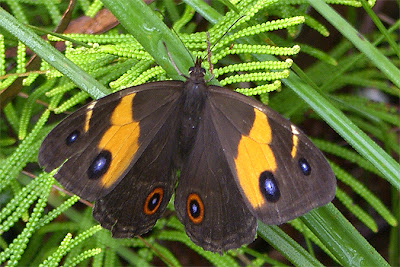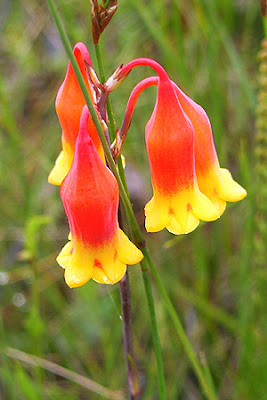 The Sword-grass Brown Butterfly (Tisiphone abeona) is a feature of the sandstone heathlands, over the summer season. I remember this butterfly from my (very much) younger days, in Springwood, in the Blue Mountains. Most recently I saw it at Manning's Lookout (on the top of the escarpment, above Kangaroo Valley). Today I saw a number of these large butterflies at the Carrington Falls area. As this photo shows, this one was hanging out amongst Coral Fern and Sword-grass (Gahnia). Both these plants are typical of moist areas on sandstone, in the Southern Highlands. As indicated by the name, this Butterfly's caterpillar feeds on Sword-grass (Gahnia sp.) Sword-grasses are very fibrous, with sharp edges, so it is remarkable that these butterflies have adopted them as their food plant.
The Sword-grass Brown Butterfly (Tisiphone abeona) is a feature of the sandstone heathlands, over the summer season. I remember this butterfly from my (very much) younger days, in Springwood, in the Blue Mountains. Most recently I saw it at Manning's Lookout (on the top of the escarpment, above Kangaroo Valley). Today I saw a number of these large butterflies at the Carrington Falls area. As this photo shows, this one was hanging out amongst Coral Fern and Sword-grass (Gahnia). Both these plants are typical of moist areas on sandstone, in the Southern Highlands. As indicated by the name, this Butterfly's caterpillar feeds on Sword-grass (Gahnia sp.) Sword-grasses are very fibrous, with sharp edges, so it is remarkable that these butterflies have adopted them as their food plant. In an open area of this reserve, I found numerous Christmas Bells (Blandfordia nobilis). Some, such as this plant, were growing in the middle of a little-used track (a fire trail).
In an open area of this reserve, I found numerous Christmas Bells (Blandfordia nobilis). Some, such as this plant, were growing in the middle of a little-used track (a fire trail).  As with one flower stem I found last week, further out on the Budderoo Plateau, this stem of flowers had achieved pollination. This particular stem had a truly remarkable rate of success.
As with one flower stem I found last week, further out on the Budderoo Plateau, this stem of flowers had achieved pollination. This particular stem had a truly remarkable rate of success.  Eight of these flowers have started to form seed pods, and only two appear not to have been successfully pollinated. One is standing upright (as they do as the flowers mature) and it might also have been pollinated. Two are still fresh (pendant) flowers. In the local area, this number of "bells" on a single stem is unusual. But to achieve pollination on so many on a single stem is extraordinary.
Eight of these flowers have started to form seed pods, and only two appear not to have been successfully pollinated. One is standing upright (as they do as the flowers mature) and it might also have been pollinated. Two are still fresh (pendant) flowers. In the local area, this number of "bells" on a single stem is unusual. But to achieve pollination on so many on a single stem is extraordinary.On the track back to the car, I found this relatively large-flowered "eggs and bacon" flower. It was just a small plant, about 600 mm high - so it did not stand above the dense growth of rushes and grasses of the sandstone heathland.
 It is Pultanea tuberculata (synonym P. elliptica). Many of the Eggs and Bacon flowers ("Pea flowers") are quite small, but this one had small leaves, about 5mm long, and the flowers were approximately 1cm long. Bright orange inside the "standard", and red outside on the standard and keel. A lovely bright flower. The effect of the flowers is increased by the way the flowers are clustered near the tip of the growing stem.
It is Pultanea tuberculata (synonym P. elliptica). Many of the Eggs and Bacon flowers ("Pea flowers") are quite small, but this one had small leaves, about 5mm long, and the flowers were approximately 1cm long. Bright orange inside the "standard", and red outside on the standard and keel. A lovely bright flower. The effect of the flowers is increased by the way the flowers are clustered near the tip of the growing stem.

No comments:
Post a Comment